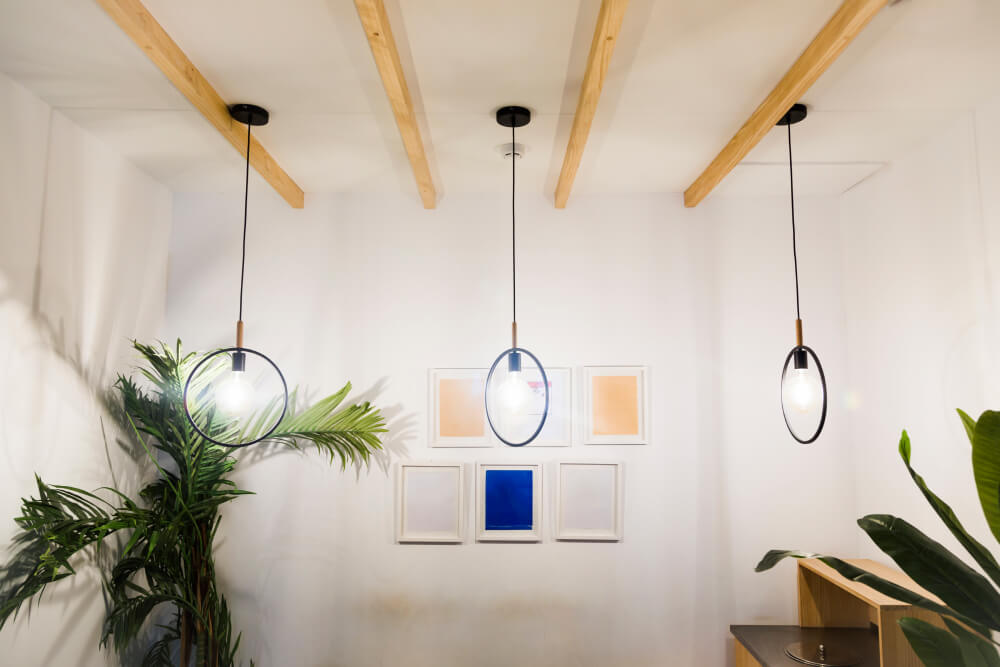Introduction
An uninteresting room can be transformed into a warm, cozy, and aesthetically pleasing setting with the help of the correct lighting. Lighting is essential in determining how your house feels overall, whether you want to emphasize particular elements, create a comfortable ambiance, or add a dash of style. Lighting does more than just illuminate a room; it also establishes the mood, highlights architectural elements, and influences productivity and mood. While dim lighting can make a space seem drab, small, or uninspired, well-lit rooms feel more welcoming.
Selecting the ideal lighting type involves more than simply practicality; it also involves combining form and function in a way that enhances your individual style. There are innumerable ways to improve the atmosphere of your house, from strategically using various light sources to altering the brightness. Regardless of the time of day or mood you want to create, this post will discuss important lighting techniques to help you improve your living areas. It will include both doable suggestions and imaginative ideas to make sure your house is wonderfully lit. Knowing the many kinds of lighting and how they complement one another can enable you to design a more welcoming, cozy, and fashionable ambiance throughout your house.
1. Layering Your Lighting for Versatility
One of the best methods to improve the atmosphere in your house is to layer your lighting. This method creates a dynamic and flexible lighting system by integrating several light sources at different heights, angles, and intensities.
Explanation:
When we talk about layering lighting, we’re referring to combining different types of light sources—such as ambient, task, and accent lighting—to meet different needs and moods. Ambient lighting provides overall illumination, task lighting focuses on specific activities like reading or cooking, and accent lighting highlights architectural details or decorative elements.
For example, in a living room, you might use overhead lighting or ceiling-mounted fixtures for general illumination, table lamps or floor lamps for task lighting, and wall sconces or pendant lights to draw attention to artwork or architectural features. This layered approach ensures that your space feels both functional and aesthetically pleasing. It also allows for flexibility, so you can adjust the lighting to suit various activities throughout the day or night.
Why It Matters:
Avoid harsh or flat lighting, which can give a room a cold or uninviting feel, by using layered lighting. Rather, it creates highlights and shadows to add depth and intrigue. Additionally, by providing several light zones that enhance one another, layered lighting can give the impression that a space is larger and more welcoming.
2. Use of Natural Light to Enhance Ambiance
Natural light is one of the most powerful tools for enhancing the ambiance of a home. It has the ability to brighten up a space, create a sense of openness, and bring life to a room.
Explanation:
Maximizing the use of natural light can instantly elevate your home’s ambiance. Large windows, glass doors, and skylights are great ways to bring in an abundance of natural light. During the day, natural light brightens up spaces, creates a connection with the outdoors, and helps to reduce the need for artificial lighting.
Consider using sheer curtains or blinds that can filter the light without blocking it entirely. This allows you to control the intensity and diffusion of natural light. For rooms that don’t get enough direct sunlight, strategically placing mirrors opposite windows can help reflect light and make the space feel brighter and more expansive.
Natural light also varies throughout the day, shifting from warm tones in the morning to cooler tones in the afternoon. Embracing this natural rhythm can help create a dynamic ambiance that changes with the time of day, enhancing the overall experience of your home.
Why It Matters:
Natural light fosters a sense of well-being and has been linked to improved mood and productivity. By incorporating more natural light, you can reduce your reliance on artificial lighting, lower energy costs, and create a more sustainable home environment. Additionally, rooms filled with natural light often feel more inviting, making them ideal for entertaining or relaxation.
3. Choosing the Right Fixtures and Bulbs
The type of light fixture and bulbs you select plays a significant role in shaping the ambiance of your home.
Explanation:
Any room’s ambiance can be influenced by the various lighting effects produced by various fixtures and bulbs. Pendant lights and chandeliers, for example, are excellent statement pieces that give dining rooms and living areas a sophisticated and beautiful feel. In bedrooms and reading nooks, floor and table lamps are excellent for giving job illumination and warmth.
The atmosphere is also impacted by the sort of bulbs you select. Cooler white or LED bulbs provide a more contemporary, energy-efficient illumination, while warm white or incandescent bulbs give off a warm, inviting glow. Dimming capabilities should also be taken into account. You may change the brightness of fixtures with dimmer switches to create the mood you choose, whether it’s a soft, calming light or a bright, stimulating setting.
Additionally, selecting fixtures that complement your home’s decor can add a layer of sophistication and style. For instance, a mid-century modern pendant light might add a touch of retro charm to a living room, while a sleek, contemporary floor lamp might enhance a modern space.
Why It Matters:
Choosing the right fixtures and bulbs not only impacts the mood of a room but also contributes to the overall aesthetic. Poorly chosen fixtures can disrupt a space’s design, while well-matched elements enhance the visual appeal and create a cohesive look.
4. Accent Lighting to Highlight Key Features
Accent lighting focuses on specific features, objects, or architectural details in a room, drawing attention and creating a sense of depth and dimension.
Explanation:
Accent lighting is designed to highlight specific elements like artwork, architectural features, or decorative objects such as sculptures or plants. It creates a sense of drama and interest, making these focal points stand out. For example, wall-mounted picture lights or directional spotlights can beautifully illuminate artwork, while strip lighting under cabinets or behind furniture highlights texture and depth.
Track lighting is another great option for creating accent lighting, allowing you to direct the light exactly where you want it. Similarly, LED tape lights can be used under countertops, shelves, or behind furniture to create soft, ambient glows that enhance the space’s visual appeal.
Accent lighting can transform a dull corner into a cozy reading nook or spotlight unique architectural details like crown molding or exposed brick walls. By drawing attention to these features, you add personality and character to your home, making it feel more personalized and inviting.
Why It Matters:
Accent lighting helps to create visual interest and break up a room’s overall lighting, preventing a flat or one-dimensional look. It adds depth and dimension, making a space feel more layered and sophisticated. In addition, accent lighting can contribute to a sense of luxury or coziness, elevating the overall ambiance of your home.
5. Dimmer Switches for Adjustable Ambiance
Dimmer switches are a simple yet highly effective tool for creating adjustable lighting in any room.
Explanation:
Installing dimmer switches allows you to easily adjust the brightness level of your lights, transforming the mood of a space from bright and energetic to soft and calming. This is particularly useful in spaces like bedrooms, living rooms, and dining areas, where the ambiance might vary depending on the time of day or the activity.
For instance, during the evening, you might want dim lighting to create a cozy and intimate atmosphere for winding down, while in the morning, brighter lighting helps to energize the space. Dimmer switches also pair well with layered lighting setups, offering more control over each light source.
Another advantage of dimmers is energy efficiency. By reducing the brightness, you use less power, which can contribute to lower electricity bills. Additionally, dimming certain lights while keeping others at full brightness allows you to highlight specific areas of the room, creating a more dynamic and visually appealing space.
Why It Matters:
Dimmer switches offer flexibility and customization, allowing you to adapt the lighting to your needs and preferences. They can transform a space’s ambiance without the need for multiple fixtures, simplifying your setup while enhancing the overall comfort and style of your home.
6. Using Task Lighting for Functionality and Comfort
Task lighting focuses on providing direct, focused light for specific activities, ensuring that tasks are performed efficiently and comfortably.
Explanation:
Task lighting is essential for areas where you require precise illumination to perform activities like reading, cooking, working, or grooming. This type of lighting is usually brighter and more concentrated than general or ambient lighting. In a reading nook, for instance, a floor lamp with an adjustable shade or a desk lamp with a focused beam provides the perfect amount of light for comfortable reading without straining the eyes. Similarly, under-cabinet lighting in kitchens helps illuminate countertops, making food preparation easier and safer.
Task lighting is not only practical but also enhances comfort. In spaces like home offices, well-placed desk lamps reduce eye strain and improve focus, contributing to a productive work environment. By incorporating task lighting, you ensure that functional spaces are adequately illuminated while minimizing glare and shadows.
Why It Matters:
Task lighting improves both the functionality and ambiance of a room. It ensures that specific activities are performed efficiently while reducing the need for harsh overhead lighting. By providing well-targeted lighting, you create a more comfortable and practical environment, making your home more livable and adaptable to different tasks throughout the day.

